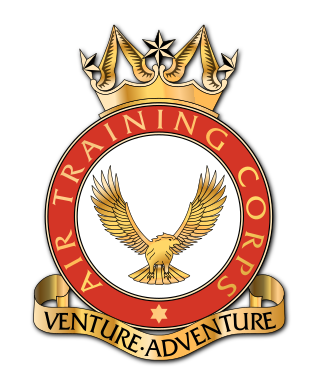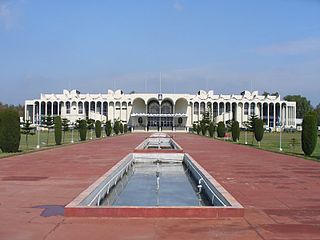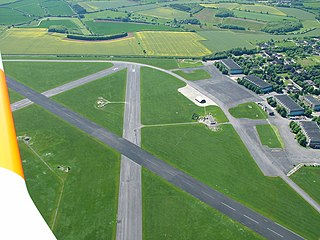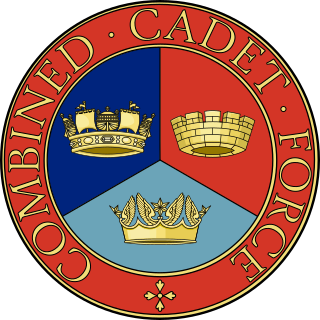
The Royal Air Force (RAF) is the air and space force of the United Kingdom, British Overseas Territories and Crown Dependencies. It was formed towards the end of the First World War on 1 April 1918, becoming the first independent air force in the world, by merging the Royal Flying Corps (RFC) and the Royal Naval Air Service (RNAS). Following the Allied victory over the Central Powers in 1918, the RAF emerged as the largest air force in the world at the time. Since its formation, the RAF has played a significant role in British military history. In particular, during the Second World War, the RAF established air superiority over Hermann Göring's Luftwaffe during the Battle of Britain, and led the Allied strategic bombing effort.

The de Havilland Canada DHC-1 Chipmunk is a tandem, two-seat, single-engined primary trainer aircraft designed and developed by Canadian aircraft manufacturer de Havilland Canada. It was developed shortly after the Second World War and sold in large numbers during the immediate post-war years, being typically employed as a replacement for the de Havilland Tiger Moth biplane.

Royal Air Force Leeming or more simply RAF Leeming is a Royal Air Force station located near Leeming, North Yorkshire, England. It was opened in 1940 and was jointly used by the RAF and the Royal Canadian Air Force (RCAF). Between 1950 and 1991, it operated mostly as a training base with Quick Reaction Force (QRF) Panavia Tornado F3 fighters based there in the latter stages of the Cold War and into the early 21st century. Since 2006, it has become the home of the deployable RAF communications cadre and the home of No. 135 Expeditionary Air Wing.

The de Havilland DH.82 Tiger Moth is a 1930s British biplane designed by Geoffrey de Havilland and built by the de Havilland Aircraft Company. It was operated by the Royal Air Force (RAF) and other operators as a primary trainer aircraft. In addition to the type's principal use for ab initio training, the Second World War had RAF Tiger Moths operating in other capacities, including maritime surveillance and defensive anti-invasion preparations; some aircraft were even outfitted to function as armed light bombers.

The Air Training Corps (ATC) is a British volunteer youth organisation of the United Kingdom; aligned to, and fostering the knowledge and learning of military values, primarily focussing on military aviation. Part of the Royal Air Force Air Cadets (RAFAC), the ATC is sponsored by the Royal Air Force (RAF) and the wider Ministry of Defence (MoD). The majority of Air Training Corps staff are volunteers, though some staff are paid for full-time work; including Commandant Air Cadets, who is a Royal Air Force officer as part of a Full Term Reserve Service commitment.

The Royal International Air Tattoo (RIAT) is the world's largest military air show, held annually in July, usually at RAF Fairford in Gloucestershire, England in support of The Royal Air Force Charitable Trust. The show typically attracts a total of 150,000 to 200,000 spectators over the weekend.

Royal Air Force Henlow or more simply RAF Henlow is a Royal Air Force station in Bedfordshire, England, equidistant from Bedford, Luton and Stevenage. It houses the RAF Centre of Aerospace Medicine, the Joint Arms Control Implementation Group (JACIG) and the Signals Museum. It formerly hosted light aircraft flying and 616 Volunteer Gliding Squadron. The Ministry of Defence announced on 6 September 2016 that the base is set to be close. As of January 2024, the closure and disposal of the station is expected to take place from 2026. Flying activity ceased in July 2020.

The Grob G 115 is a general aviation fixed-wing aircraft, primarily used for flight training. It is built in Germany by Grob Aircraft. The E variant with a 3-blade variable pitch propeller is in service with the Finnish Air Force, the Royal Navy and Army Air Corps for Flying Grading and in the Royal Air Force as part of No. 6 Flying Training School which provides flying to both University Air Squadrons and Air Experience Flights to Cadets of the Royal Air Force Air Cadets. As of 2020, the Tutor is still being used by the RAF for some Elementary Flying Training (3FTS) but is due to be phased out in favour of its replacement, the more advanced Prefect T1.

The Pakistan Air ForceAcademyAsghar Khan is an accredited three-year military academy which provides undergraduate education to officer candidates for the Pakistan Air Force.

Royal Air Force Little Rissington or more simply RAF Little Rissington is an Royal Air Force satellite station in Gloucestershire, England. It was once home to the Central Flying School, the Vintage Pair and the Red Arrows.

The Central Flying School (CFS) is the Royal Air Force's primary institution for the training of military flying instructors. Established in 1912 at the Upavon Aerodrome, it is the longest existing flying training school. The school was based at RAF Little Rissington from 1946 to 1976. Its motto is Imprimis Praecepta, Latin for "The Teaching is Everlasting".

Number 92 Squadron, also known as No. 92 Squadron and currently as No. 92 Tactics and Training Squadron, of the Royal Air Force is a test and evaluation squadron based at RAF Waddington, Lincolnshire. It was formed as part of the Royal Flying Corps at London Colney as a fighter squadron on 1 September 1917. It deployed to France in July 1918 and saw action for just four months, until the end of the war. During the conflict it flew both air superiority and direct ground support missions. It was disbanded at Eil on 7 August 1919. Reformed on 10 October 1939,at Tangmere Airfield, the unit was supposed to be equipped with medium bombers but in the spring of 1940 it became one of the first RAF units to receive the Supermarine Spitfire, going on to fight in the Battle of Britain.

The Royal Auxiliary Air Force (RAuxAF), formerly the Auxiliary Air Force (AAF), together with the Air Force Reserve, is a component of His Majesty's Reserve Air Forces. It provides a primary reinforcement capability for the regular service, and consists of paid volunteers who give up some of their weekends, evenings and holidays to train at one of a number of squadrons around the United Kingdom. Its current mission is to provide trained personnel in support of the regular RAF.

A Volunteer Gliding Squadron (VGS) is an aircraft squadron of the Royal Air Force (RAF) which provides flying training in glider aircraft for Royal Air Force Air Cadets. All current operational Volunteer Gliding Squadrons operate a sole type of aircraft, the Grob G103A Twin II Acro, a conventional winch-launched tandem-seat sailplane known by its British military designation, Viking T1.

Raynham George Hanna, was a New Zealand-born fighter pilot who emigrated to England to join the Royal Air Force (RAF). During his RAF career he was a founding member of the Red Arrows aerobatics display team. He also founded The Old Flying Machine Company, which commercially flies Second World War vintage fighter aircraft at air displays around the world, and for television and cinematic productions. He was a Spitfire display pilot in the latter half of the 20th century, noted for his daring aerobatic stunt flying.

The Royal Air Squadron Trophy Competition, also known as the National Ground Training Competition, was created as a way for CCF(RAF) sections to contest the Air Squadron Trophy.
Air Vice Marshal John Frederick George Howe, was a senior Royal Air Force officer in the 1970s and 1980s. He flew combat missions in the Korean War and North Sea interceptor air patrols during the Cold War, finishing his career as the Commandant General RAF Regiment and RAF Provost Marshal and Director General Security. Howe also served as the sixteenth Commandant of the Royal Observer Corps between 1977 and 1980.

The Oxford University Air Squadron, abbreviated Oxford UAS, or OUAS, formed in 1925, is the training unit of the Royal Air Force at the University of Oxford and forms part of the Royal Air Force Volunteer Reserve. OUAS is one of fifteen University Air Squadrons that are spread out across Great Britain and it recruits from the universities at Oxford and Reading University.
Wing Commander Michael Philip Westwood OBE is a retired Royal Air Force officer.

Fowlmere Airfield is a small airfield located 4.2 miles (6.8 km) northeast of Royston, Hertfordshire and 8.8 miles (14.2 km) southwest of Cambridge, Cambridgeshire, England. It was previously a Royal Air Force satellite station, RAF Fowlmere.


















